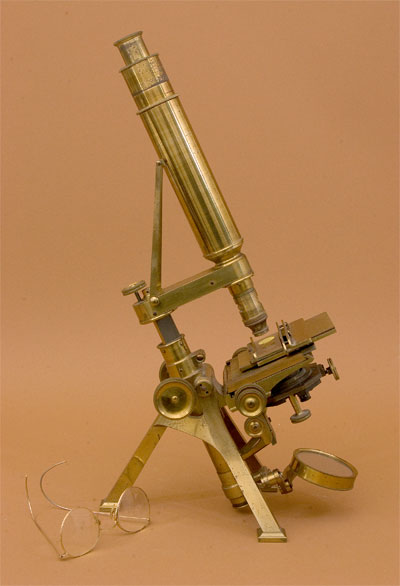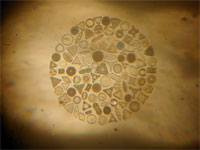 |
|||||
 |
 |
||||
 |
|||||
 |
 |
||||
Powell & Lealand Model No. 2—Large Compound Microscope (No. 151 ) |
|||||||||||
 |
Age: 1858 Made by: Powell & Lealand Made in: England |
||||||||||
 |
|||||||||||
 |
|||||||||||
|
The firm of Powell & Lealand resided at this address from 1857–1905*.
|
|||||||||||
 |
|||||||||||
|
Imaging
|
|||||||||||
|
This instrument is an early example of "Model No. 2—Large Compound Microscope" of the Powell & Lealand microscope line that was introduced in 1843. It is smaller than their most famous Model No. 1, yet still large and well equipped. The instrument was designed to be a Universal Microscope and therefore useful for a number of microscope optical techniques (brightfield, darkfield, PLM, camera lucida). "No instrument can be better adapted than this to all the ordinary (sic) wants of the Microscopist..." (Carpenter, 1856). It was lighter, less complex, and cost less than P&L's Model No. 1 as well as other universal microscopes of the era (e.g., Ross). The Golub Collection has examples of the P&L Model No. 1, a binocular Model No. 2, and an early Student microscope. The instrument displayed here was manufactured in 1858, as shown by the engraving under the fine-focus knob. It is signed “Powell & Lealand 170 Euston Road, London” on top of the limb. The microscope is supported on a broad triangular base and pivots at its center of gravity. Coarse focus is by rack & pinion. Fine focus is via the "long arm" spring-loaded mechanism. The microscope optics consists of a Carl Zeiss objective with an integrated Nicol prism analyzer, a body and drawtube (with an aperture but no field lens), and a single Huygenian eyepiece. The microscope body is screwed into the fine focus limb and is stabilized by two oblique stays attached to the top of the limb. This model includes a mechanical, achromatic condenser with counter-rotating disks containing apertures and/or darkfield stops. The polarizer is missing from this instrument, but would have been mounted in a substage carrier. The sample stage can rotate and has X & Y mechanical movement with the Turrell's arrangement of control knobs. The illuminating mirror is mounted on an articulated arm and a single-side gimbal. The only accessories with this instrument are two sample slides and a circular live-box. The microscope can be stored in a large mahogany case. Imaging is good, considering the low magnification of the Zeiss lens. *Turner, GL'E. 1989. The Great Age of the Microscope. p114. Featured 01/2009 |
|||||||||||